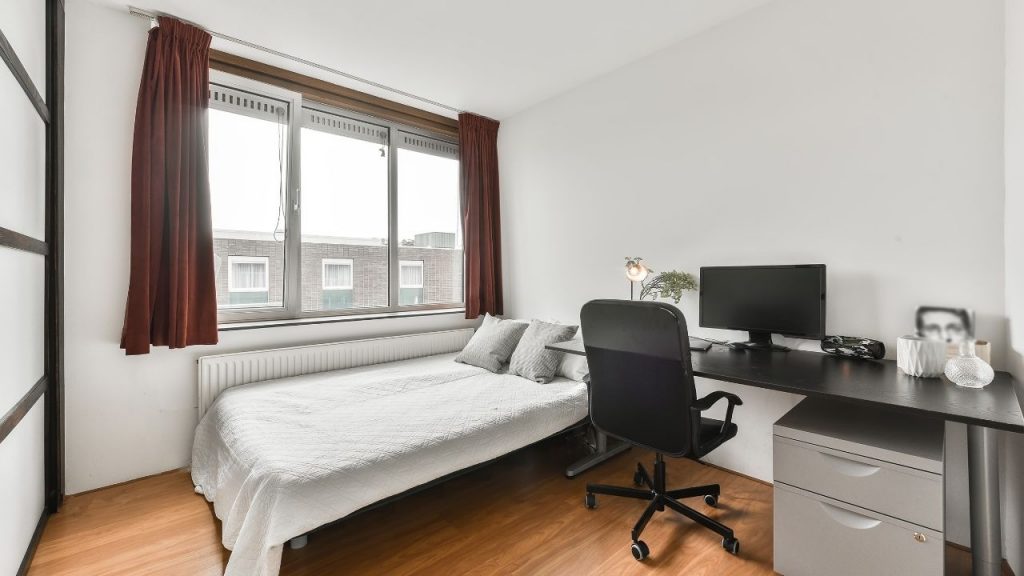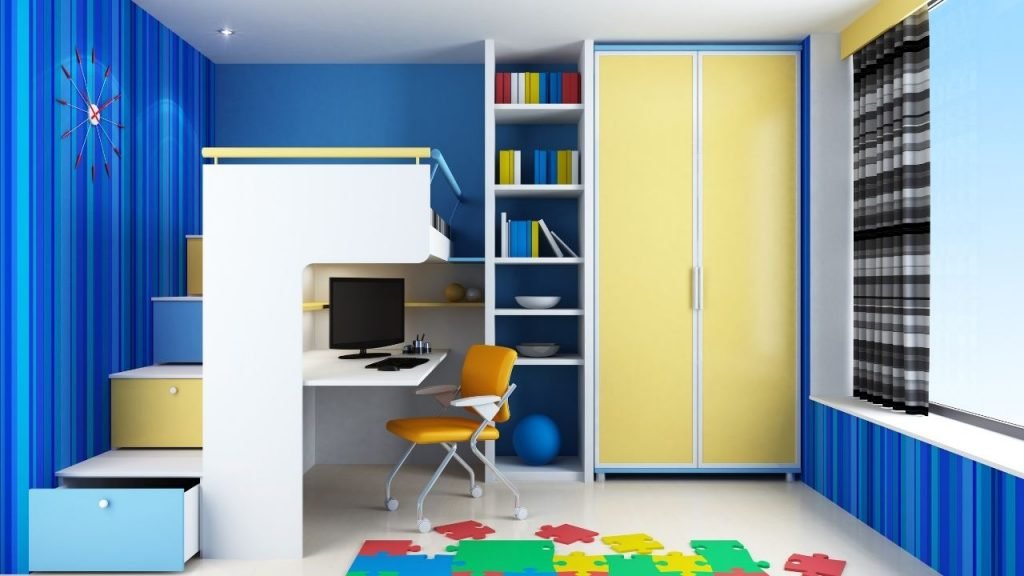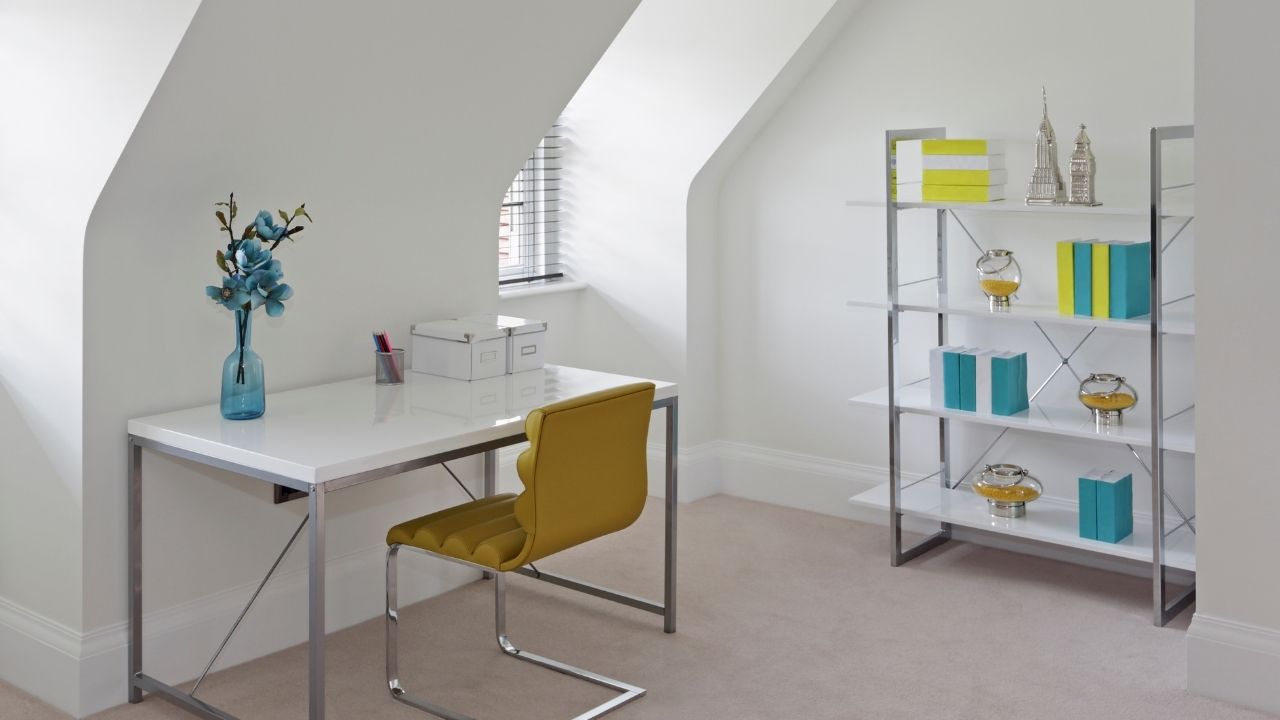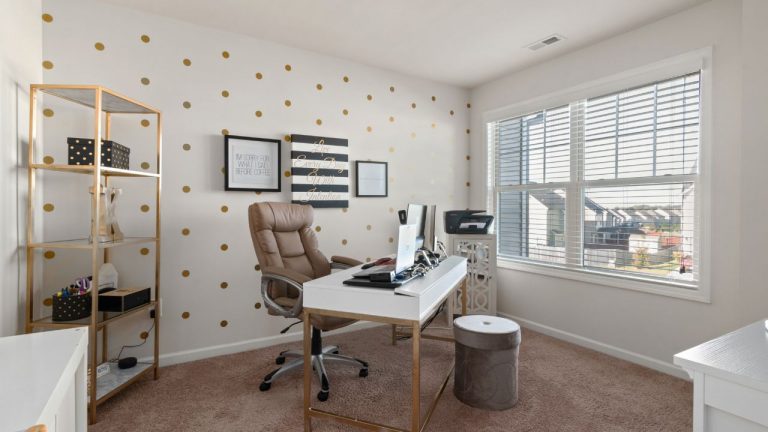Can You Set Home Office In Your Bedroom? [Pros & Cons]
The pandemic is over. But the work style it taught us is going to stay longer than we expected. And, who knows? We are currently heading towards a world where “work from home” is the norm.
It’s better to adapt to this culture before that. So, how do people work from home? Can you set the home office in your bedroom?
You can set the home office in your bedroom if the house lacks enough space. Installing a partition between the office desk and the bed will help to distinguish both areas. However, the garage, kitchen table, dining space, behind the couch, even the garden shed can be transformed into a functional home office.
If you are in the process of setting up a home office in your home, you are at the right place. Here, we will discuss whether you should use the bedroom as a home office or not. Not just that, we will give some solid ideas to improve your work from home experience.
So, without wasting any more time, let’s start right away.
Is It OK To Have Home Office In Bedroom?
When the pandemic forced us to adapt to remote work, most of us didn’t have a separate workstation at home. We squeezed our laptops, desktops, and reading materials into the bedroom.
It was the most comfortable place at the home. You get a comfy mattress to sit on and lots of pillows to support the back. Plus, taking a quick nap is a breeze.
That’s the reason, why the bedroom is our first choice to do office work. But, as much as we would love to support the idea of setting up a functional office area within the room, we can’t.
You can use the bedroom as a temporary solution to complete your tasks. But, it is going to kill a lot of your time and energy if you keep it that way. And, you shouldn’t treat the home office as anything less than an actual office.
Try other areas first to set the office up. Only go for the bedroom if other methods fail.
You might ask, if not the bedroom, then what’s the best place to set up a home office? We have discussed this topic in the latter segments in detail. Keep on reading to find the answers.
Why You Shouldn’t Have Your Office In Your Bedroom
Imagine you are talking to important clients on the zoom and your toddler starts crying. It’s not their fault though. Your children or pets know that you work outside. Being in bed means that you are free now and they want your attention.
It’s a huge downside of working in your bedroom. You will also start feeling burned out sooner than expected. Remote employees often complain that their sleep and lifestyle are greatly hampered due to not having an office to go to.
There is no schedule anymore. As a result, it gets harder for the brain to stay motivated and complete the task when you can see others sleeping.
Most of all, you can never leave work and “go home.” The work is with you 24×7. You might end up getting late and start watching shows online and waste the morning. And, then stay up all night and work like a zombie to meet the client’s deadline.
The problem is, that it is not a one-time thing. The root cause of all the issues we just mentioned, is making the bedroom your office.
How Do I Separate My Bedroom With Home Office?
The joy of making the bed in your office only lasts a while. After that, the painful reality hits you hard. And, that’s when you say, enough is enough. You need to separate the home office even if it’s within the bedroom area.
However, you can’t just put a desk in the middle of the room and expect the productivity level to rise. We have some tips that can help you achieve the most from your home office in the bedroom.
Here we go.
- Have a desk just for office work. You might be tempted to use the reading table beside the bed. You mustn’t do that. Our goal is to separate your work and personal life.
- The bedroom space won’t allow you to get a large desk. In that case, try installing wall storage or shelf. You can keep important files and books there saving a lot of space on the desk. If you do online work, you can skip the extra storage requirement.
- Here, we have to say something opposite to general interior rules. You need to face the desk towards a wall or window. It’s better if you can find a window to feel less confined. The purpose is to keep the bed behind your back.
We all understand the temptation to just get up from the chair and lay on the comfy bed. And, that’s what we are trying to avoid at all costs.
- Also, it is important to separate the two areas. It helps you prevent checking office emails after work hours. The best solution is to install a physical object between the areas to act as a reminder.
For example, use some curtains. It blends well with the bedroom environment and doesn’t look out of place. Once you close the curtains, consider it the end of office work for the day.
- The bedroom isn’t designed to accommodate so much furniture in it. That’s why having all the office essentials can be a hard task. We recommend getting some multipurpose items for the bedroom.
For example, a bed that can be folded against the wall or foldable chairs. You will easily find such smart furniture options in any Ikea store.

Where Should I Put My Home Office?
The ideal option is to use a spare room. You can easily get away with a small area that can fit a standard desk along with other office essentials. If your house doesn’t have a dedicated office area, we suggest you turn a regular room into one.
We are emphasizing getting a full room because it gives you an extra “workstation” feel. You can finish your workday and leave the room. It keeps you more focused on the task at hand and at the end of the day, you can “go home” like any other employee in the world. This feeling is precious.
You are lucky if the house comes with a designated study room. But, that’s not mandatory. For example, if there are two guest rooms, you can convert one into a home office.
However, that’s not the only way. You can use a room for a dual purpose. We will elaborate on this topic in the latter segment of this article. So, stay with us.
Things To Consider While Setting Up A Home Office
1. Good Lighting
Having sufficient lighting in your home office is a must. Especially if you are the most productive during the nights. It would be best to have a small window to pass natural sunlight into the room.
Warm and natural lights are good for our eyes. Attach some curtains in case, the sunlight starts glaring into your monitor. Curtains will help you reduce the effects as you desire.
That doesn’t mean you will rely upon the sun only. We suggest going for some full-spectrum LED lights to lighten up the room. These bulbs mimic the natural warmth of the sunlight.
For more directed lighting as you work, you can get a desk lamp. It helps you to focus on writing, reading papers, or typing on a laptop. But, make sure to keep it at a distance so it doesn’t cast a shadow on the desktop screen.
A useful tip is to check the Kelvin ratings of the bulb before buying it. The higher the kelvin rating, the harsher it will feel on the eyes.
2. Proper Space
No matter which room or place you choose to establish a home office, it must have enough space. Now, what’s the ideal space depends highly on the kind of work you do. Sometimes, you need to hold meetings with your team members from time to time to discuss a project.
In that case, you will need space for a couch and coffee table area along with the desk and chairs. If you are a couple working from home, you will need a large desk that accommodates two personal desktops and other essentials with ease.
If your job involves a lot of reading, you would probably need a separate bookshelf to keep the reference books close. Each of these scenarios needs a different type of office space within the house.
Make sure the room is equipped with all the built-in tech facilities. For example, it should have a dedicated Wi-Fi router, enough sockets to charge the gadgets, etc. It would be pointless if you have to get up from the chair frequently to use an electronic device.
3. Standard Desk height
Desk height is something a normal employee never has to worry about. Luckily, the office is always furnished with desks that suit the height of an average person and provides the most comfort while working. Since we are building an office of our own, we need to measure the desk height too.
If it is “too high” or “too low” it can make us slump over the desk. As a result, we end up experiencing back pain.
The office standard desk height is 29 inches. If you want the desk height to fit you perfectly, sit on a chair and mimic a working posture. Now, measure the distance between your forearm and the floor. Make sure the arms are parallel to the ground. That’s the desk height you need.
In case you need to type on a desktop, keep the desk height a little lower. The keyboard height will make up for that and you will be able to type on the computer without losing your posture.
Plus, you can use a board while writing something on a file. This way, you can maximize your comfort.
4. Locating The Desk
Many people choose the wrong layout while placing the desk in a room. It highly impacts our work experience.
- First of all, avoid a layout that places the wall just behind your chair. It is the most awkward setup you can imagine. People like to move around the ergonomic chair as they work behind a desk.
It just breaks the monotony of sitting in a place for such a long time. But, with nothing but a wall behind the chair, you lose that precious opportunity.
- Place the desk closer to the main source of light within the room. If the window allows sufficient sunlight to pass through it, make sure the desk faces that way. That way, you can save on the electricity bill too.
- If the entrance doesn’t have a door, it can be distracting. Place the desk in a way so that every new person passing the entrance doesn’t catch your eye.
5. Office Chair
Sadly, we don’t give due importance to an office chair while furnishing the office. It’s only after an experience of severe back pain, that we start noticing our mistake.
Never pick a static dining chair for that purpose. Looking aesthetic is not the only job of an office chair. It helps you maintain a straight posture throughout the shift.
We suggest getting an ergonomic chair with lumbar support. Look for the backrest shape and whether the seat is adjustable or not. If it mimics the shape of our spinal structure, you will feel less stressed and sore.
Check out our article on how office chairs help with back pain.
What To Do If You Don’t Have A Spare Room?
Here is the interesting part. If you don’t have a spare compartment, you can use some space in an already existing room.
- You can use a Murphy bed, in one of the bedrooms. Murphy beds are a space saver. People with smaller apartments love these beds. It allows you to use one single room for multiple purposes. You can fold it out of the wall at night. And, for the rest of the day, use the room as an office.
- If you have a large laundry room or closet, your problem is solved. You can easily set up a small office in that particular area. Just make sure to invest in the lighting quality, so that your eyes don’t feel the burden.
- Do you have a long dining area? Many houses have an in-built dinner area that can accommodate a lot of guests. However, you don’t have guests every day. Plus, kitchen tables and TV rooms are the most preferable places to grab a meal nowadays.
That means you can use the dining space to establish a personal workstation. If you don’t want to ruin the aesthetics, try attaching a sliding door too. A curtain will also do the work if you are okay with it.

Should You Work In The Same Room You Sleep?
A report suggests that almost 80% of employees worked from bed when they meant “work from home.” Well, we can’t blame them. Most of the workers didn’t feel the need for a separate home office, as the situation was temporary. But, did it improve their quality of life? Let’s dig a little deeper.
First of all, employees complained about the mental exhaustion during this period. Yeah, they had the freedom to drink coffee while working and wear whatever they feel like. But, the issues at hand were far more severe than the comfort.
- When you bring gadgets like laptops and mobile phones to your bed for work, it ruins the sleeping cycle. Our brains are trained to associate bed with sleeping from an early age. When you sit on the bed, your brain prepares the body to relax and wind up.
But here, you are expecting the complete opposite. The logic is simple. You can’t be the most productive at a place designed to sleep. If you continue to work from bed, it will take you more hours to complete a small job.
That’s why most employees complain that they have to work for more hours when they are stuck at home.
- Moreover, working in the same room where you sleep without any specific partition will reduce the quality of life. As we already discussed, you won’t be able to fall asleep quickly.
Because the connection between sleep and bed has been damaged. Even though you shut the gadgets off, your brain thinks you are at work. Because you never left the “workplace” and went “home.”
Home Office In Bedroom Or Living Room- Which One To Choose
When it comes to choosing a place for your home office, the most popular options are bedrooms and living rooms. But, which one is more convenient? Let’s have a look.
Bedroom
Pros
- You can get the comfort of your bed and some pillows if the chair feels uncomfortable after some time. You won’t have to pause the work to stretch or go to another room for a nap.
- You can close the door of the bedroom and keep the noise from entering the room. It’s even better if you live in the room alone. You get maximum calmness and peace at work.
- The bedroom can be a smart solution if the house is really small. You can install a murphy bed and turn on the space-saving mode. You can avoid the urge to just lay on the bed for a while. Because there won’t be a bed on the floor during your work time.
Cons
- It will affect your sleep cycle.
- Frequent disturbance from the toddlers and pets.
- Hard to resist the comfy mattress.
- You can’t keep the main lights on after late at night. It can cause trouble for your spouse or kids.
- You have to be super quiet on the phone during the night.
- The background is messy and not appropriate for zoom meetings.
Living-room
Pros
- The living room is the brightest area within your house. So, that fills the “good lighting” requirement for a home office.
- You can cut the cost of installing LED bulbs to provide sufficient light.
- You can keep the lights on all night without causing trouble for your family members when they want to rest.
- You get the least crowd in this room compared to your bedroom.
- The background is also presentable if you have to join a zoom meeting. You won’t have to run with the laptop as your name is being called for a presentation.
Cons
- The living room is the most visually appealing in a house. If you keep the work desk messy, it will cause a visual break for the entire living room.
- When guests visit, this room will be the most crowded. It would be hard to concentrate with so much noise.
- Living-rooms don’t come with individual doors to shut the world out. You will get disrupted with every new entrance.
Wrapping Up
Working in your pajamas sounds so much fun. But, it also comes with a non-stop interruption from your pets, children, and other members. Plus, it’s harder to avoid the urge to jump into the bed and waste some time.
And, that might lead to an unsatisfactory workday for you. We suggest getting a separate office space and renovating it to your convenience. You can also set the home office in your bedroom if it is temporary. It will give you the utmost pleasure of relaxing in your bed during a high-profile meeting.
But, if you are planning to stay in the remote job mode for a longer time, the bedroom won’t be the ideal choice. Follow our guide and make a dedicated office space with a partition behind the sofa area or any other room.
Hopefully, you got the idea.


![Where Should You Place Desk In Home Office? [ Practical Guide]](https://homethereby.com/wp-content/uploads/2022/07/How-To-Connect-2-Monitors-1-Laptop-On-A-Small-Desk-768x432.jpg)

![How Small Can A Home Office Be? [Real-Life Examples]](https://homethereby.com/wp-content/uploads/2023/01/home-office-shed-768x432.jpg)
![Setting Up A Home Office Desk Against A Window [Beginners Guide]](https://homethereby.com/wp-content/uploads/2022/01/Setting-Up-A-Home-Office-Desk-Against-A-Window-768x432.jpg)

